Different Types of Napkin Folding With Procedures and Pictures

It's always a great joy to put out your fine silverware – to polish elegant cutlery, and neatly arrange crystal glasses for a beautiful dinner table.
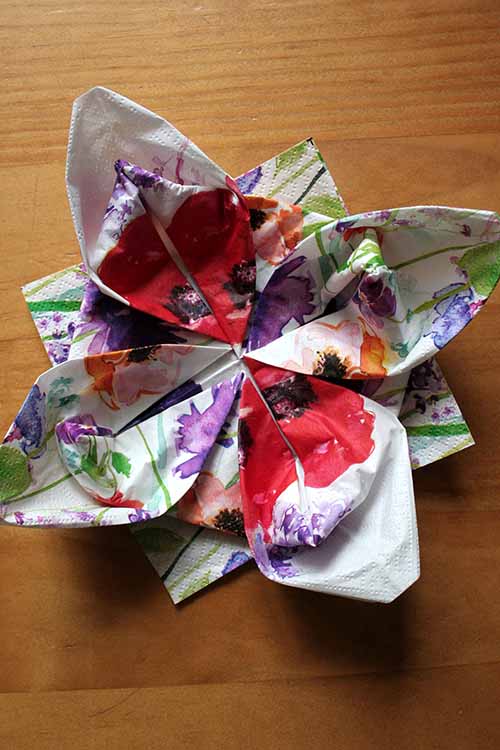
Are there any other details that could be important?
Let's face it – first impressions do count if you want to throw a fancy dinner. A beautifully folded napkin atop every plate is the icing on that cake, and is sure to strike the eyes of your guests in combination with your other arrangement flourishes!

While not all kinds of occasions require such a fine accoutrements, folded napkin decorations are nevertheless a wonderful and classic way to combine beauty, simplicity, and usefulness to add an extra special touch to the table.
History
In the past, the use of napkins – even beautifully arranged ones – looked a bit different than it commonly does today.
In fact, the proper tool to wipe your hands and mouth clean at meals before the dawn of the age of the napkin had been the tablecloth itself. You can only imagine how this must have looked at a fancy banquet!
However, new fashionable appearances at the beginning of the 17th century made it necessary to reconsider this habit. Luxurious dresses and costumes with lacy or ruffled neck braces became popular, and people just didn't want their special clothes to become dirty.
This was around the time when the napkin was invented – a piece of cloth that had the exclusive purpose of keeping you clean during eating!
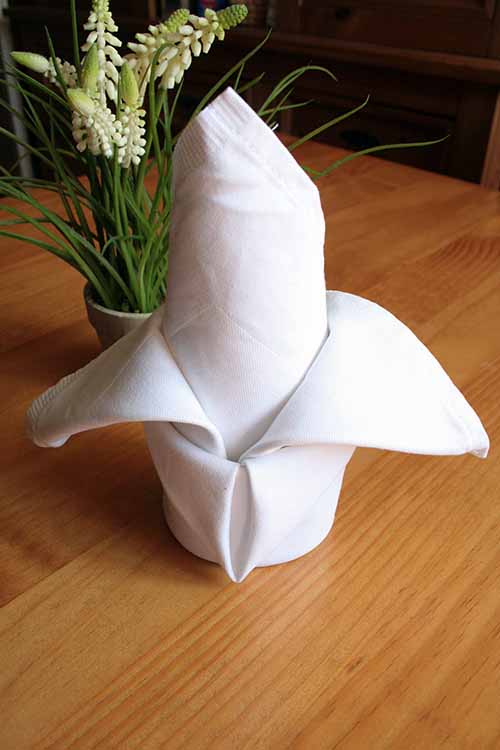
For this, strict instructions and traditions around this eating tool were developed further during the 18th century. When a napkin, plate, knife, spoon, and fork couldn't be found on the table, this was considered a total violation of decency (1).
While today many of us we use paper napkins for most occasions, the tradition of using a nicely arranged piece of cloth at the table has become increasingly rare. Sadly, cheaper paper counterparts have replaced it at most dinner tables, relegating careful folding to the status of a lost art.
My aim with this article is to revive this technique, and get everyone to start folding again!
This guide will provide you with an overview of materials, tips, and accessories. Last but not least, you will learn excellent techniques for arranging your cloth serviettes with many different examples.
If you think that your handcrafted DIY chops are not at their best, our step-by-step instructions for some of the most popular and prettiest techniques will change that – eventually helping you to become a master of this long-lost art!
What kind should you choose?
Complicated, extravagant variations and techniques can't be achieved with every type of napkin, mind you.
Paper versions, for example, are of course less suitable for this. They are too thin, too light, and too small to hold the shape you desire.
That's why fabric napkins are simply the best choice for the purpose of folding. While they are available in lots of different materials, some do work better than others.
So what should you consider when looking for a new set?
Size
The size should at least come to 20 x 20 inches. The larger they are, the easier it will be to create complicated shapes (though some of the easier techniques will work with smaller varieties, too).
Material
The most popular and suitable materials are cotton, linen, damask, or a blend of these ideal fabrics. Most high-quality napkins should also be washable at high temperatures, in order to remove stains completely.
Keep in mind that paper varieties are not all bad – for simpler occasions they suit a variety of occasions, seasons, and menus, since they are available in countless designs and colors – plus, they're disposable, an appreciated bonus for picnics, barbecues, and large less-formal gatherings.
Finishing
The prices of cloth pieces can vary quite a bit. This not only depends on material, but also on the quality of finishing.
What is finishing when it comes to napkins?
It's important to address the following questions:
- How are the seams processed?
- Are they handcrafted or do they include elaborate embroidery?
- Are they of a single hue, or multicolored?
Sometimes, a chosen cloth variety might be a bit too much of a good thing – making them straight-up unpractical. Stain removal is a pain if your selection is intricately decorated, and napkins that fray easily won't stand the test of time after a few washings.
For summer parties, casual birthdays, or barbecue feasts – particularly when more than eight guests are expected – I think paper versions are the more suitable way to go. They can be disposed of, easily replaced, or even used to soak up dropped drinks and spills without worrying about staining.
Accessories: Put a ring on it
Instead of folding cloth napkins, another equally beautiful choice is to use napkin rings.
A great advantage here: you don't need to spend lots of time folding, since you can quickly make a beautiful arrangement without it.
With some of these rings on hand, it's easy to set up a wonderful table decoration, whether you're using cloth or paper.
Plus, many different styles are available, allowing you to find the right look and type for your personal taste, to suit any occasion.
Yet, there is another way to create wonderful and eye-catching accessories: just make them yourself!
Some great ideas for lovely homemade napkin rings are:
- Using long-stemmed herbs, like chives or parsley, as a ring to wrap around the cloth
- In the same vein, using vines like ivy or nasturtium – or long grasses or reeds
- Ribbons, decorative tapes, or threads; especially those comprised of special materials (like silk, linen, felt, etc.) or with stripes, dots, or other patterns
- Sweets like candy canes, licorice, or fruit gum strings used as rings

3 Useful Tips Before You Start
1. Start with the easier techniques.
Start with the simplest forms, and work your way up to more complicated shapes.
It's always nice to have easy success in the beginning. Easy wins will encourage you to keep practicing!
2. Take your time.
Don't start your very first attempt 20 minutes before your guests arrive to your important dinner!
Practice makes perfect, so take a bit of time in the beginning – and be patient. You'll get it down eventually!
3. Press after each fold.
After every step, press the napkin tightly to maintain the creases you make. Or – if you have the time or want to be very accurate – iron after every step to strengthen creases you've created.
Though this is not mandatory to do this for all of the techniques described below, it does make a nice crisp line that will hold its shape, at least until your guests arrive and have a chance to admire your handiwork.
Starching your napkins before working also works wonders towards holding the shape you desire.
6 Awesome Techniques
Below you will find six great ideas to impress your guests.
The suggestions are organized by difficulty level, starting with quick and easy shapes and then moving into the more complex.
1. The Sail
This is probably the easiest variety that you can start with. It is prepared in the blink of an eye, and I can guarantee you that it'll work – even with smaller cloths or paper versions!
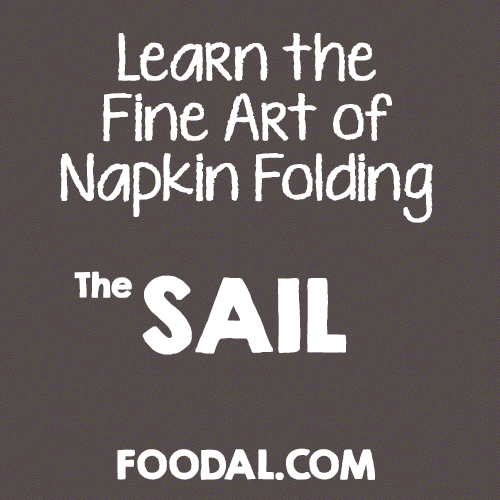
1. Spread the napkin out fully.
2. Fold the lower half upwards.
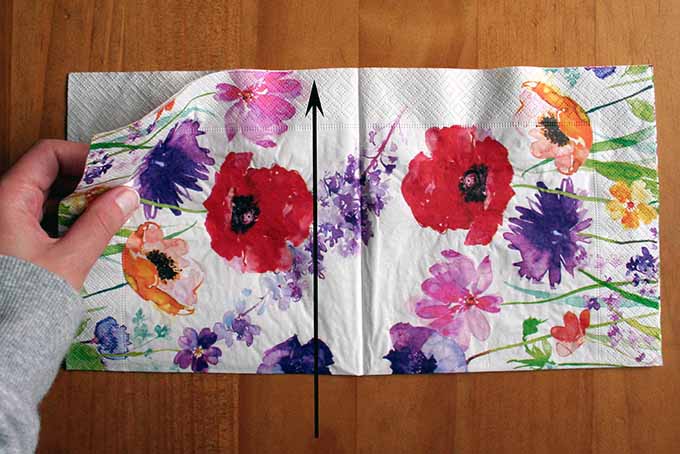
3. Bend the two outer low edges to the upper center diagonally.
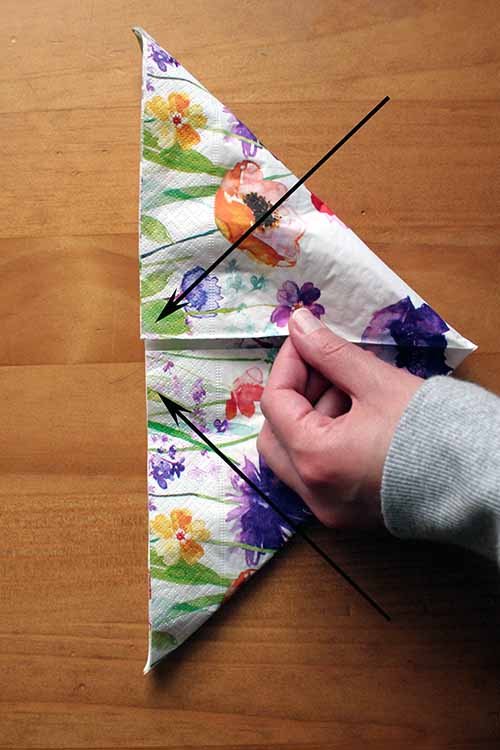
4. Press together and arrange with the tip on top.
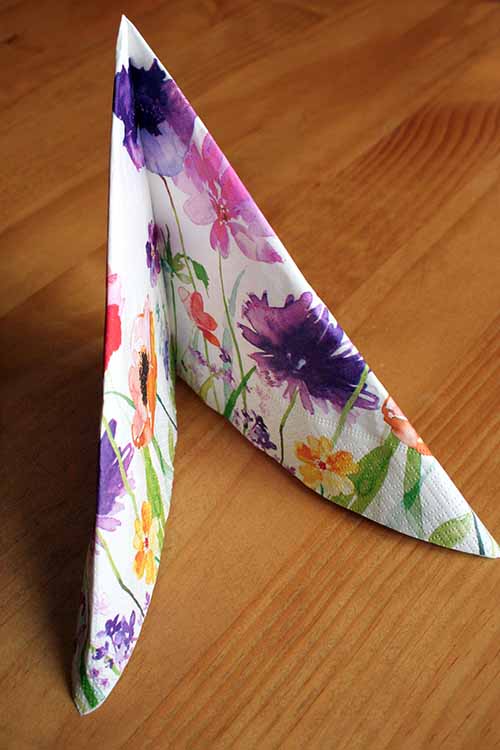
2. The Cutlery Pouch
This design is casual, yet elegant. It's a fancy way to arrange cutlery in your table setting, and looks great with patterned or decorated napkins in particular.
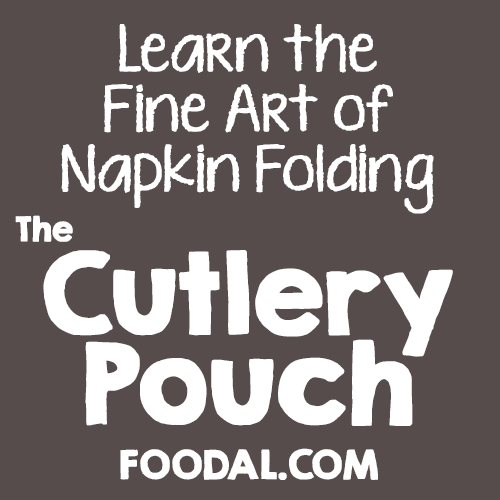
Plus, it's an easy one to prepare for a large number of guests.
1. Spread the napkin out flat on your work surface.
2. Fold in half, and then fold the top layer back to be even with the right edge.

3. Carefully flip over, then fold approximately one third towards the top and crease firmly.

4. Repeat the previous fold two times, until the cloth is used up. Put cutlery (or sprigs of herbs, a single flower, or other decorative items) into the resulting pocket.
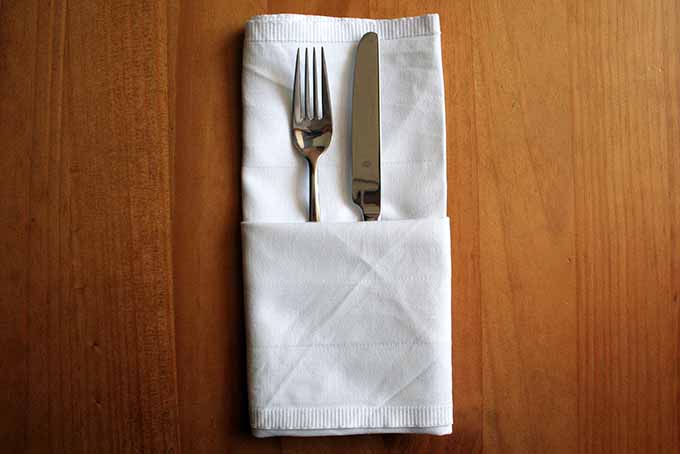
3. The Fan
A beautiful wavy form, this one provides a lively and light touch to the table.

The fan also functions wonderfully when working with particularly vibrant colors. If you want it to keep its shape for a couple of hours, it's best to iron the creases after each step.
1. Spread out your napkin, into its full rectangular or square shape.
2. Fold in half, with the crease at the left.
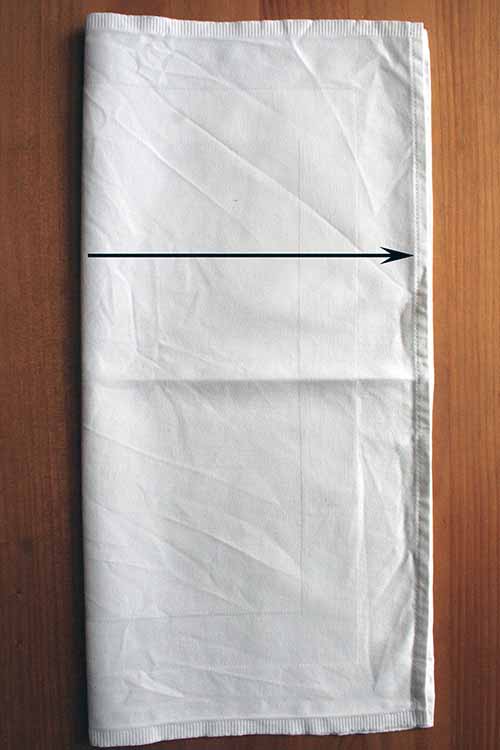
3. Start folding from the bottom up, creating according folds until you reach about two-third of the way up the cloth.

4. Carefully flip the napkin over, with the accordion fold at the bottom.
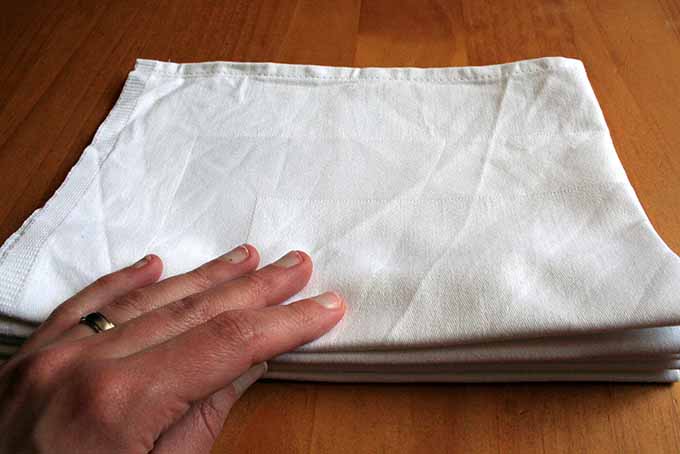
5. Fold the right half to the left edge, and crease.
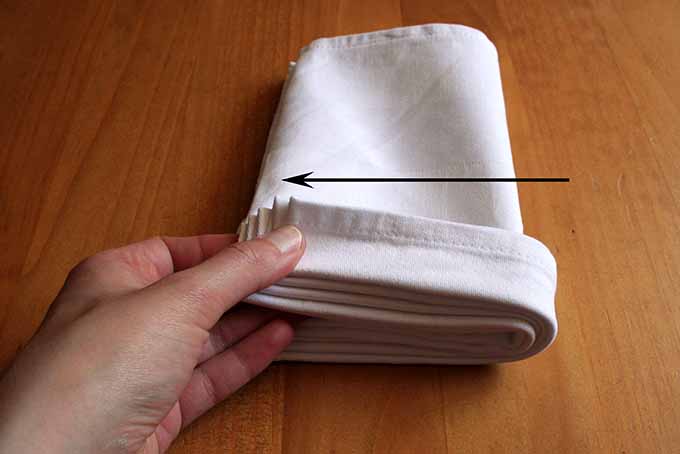
6. Take the top left corner and fold down and to the right, overlapping just above the accordion fold.
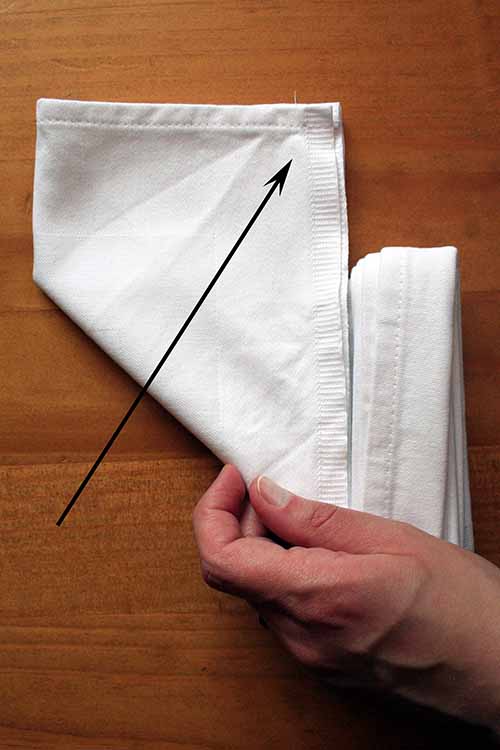
7. Carefully flip over, and bend the overhanging portion created in the last step to the center, forming a small rectangle.
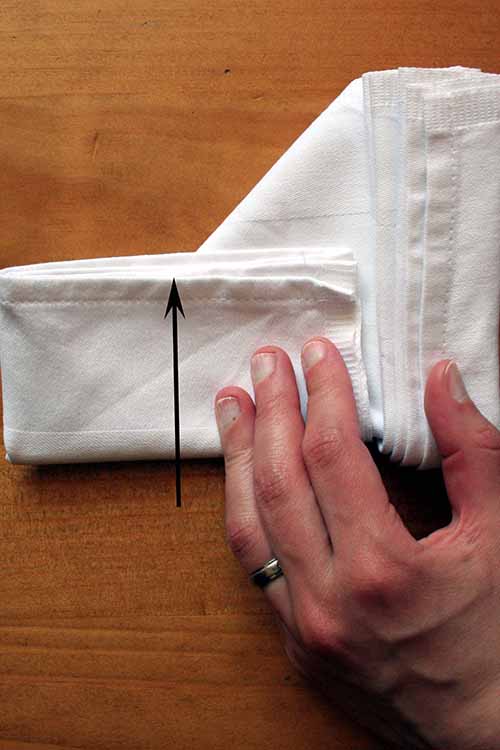
8. Press all of the creases together tightly or iron, and arrange your fan with the rectangular portion at the back.
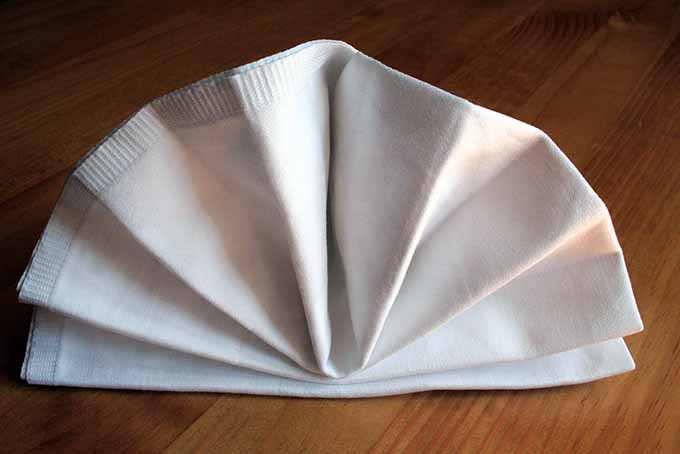
4. The Lotus Flower or Water Lily
With its very special design, this extraordinary shape is a real eye-catcher – and it's bound to impress.
When you've had some practice, this technique will also work with paper varieties.
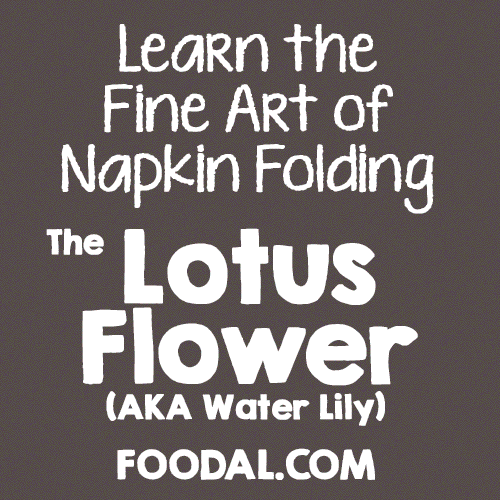
Bonus tip: use colorful napkins here, and put a small goodie inside that fits the theme of the dinner for a creative touch.
Once you've mastered one of these, making the others will go a lot more quickly!
1. Spread the napkin out on your work surface.
2. Fold all corners into the center, forming a diamond.
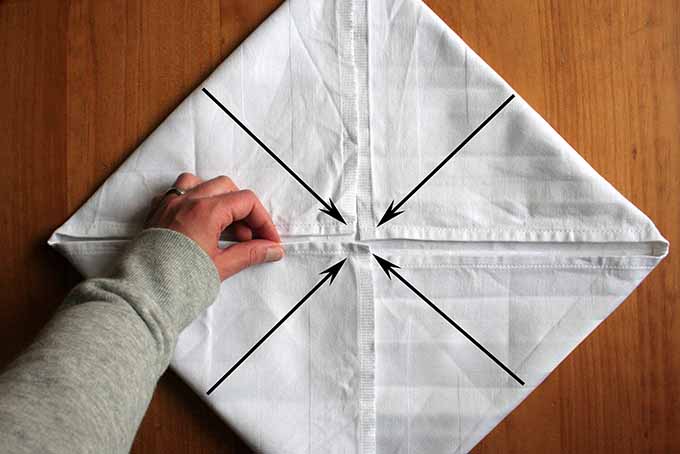
3. Repeat the step once more with all four corners, forming a square.
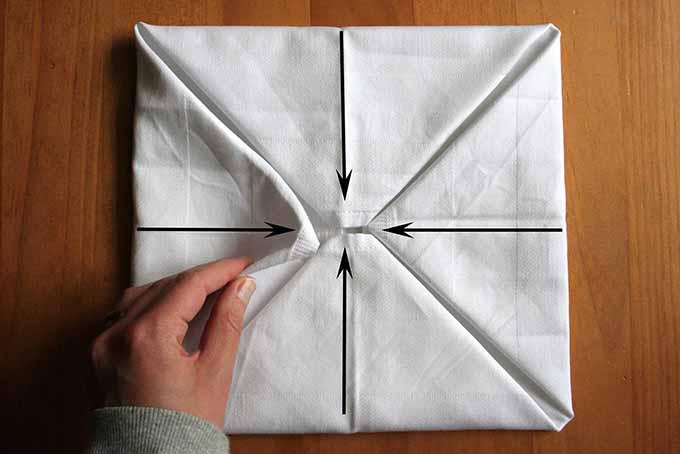
4. Flip over carefully and repeat once more to form a diamond. Press or iron the creases.
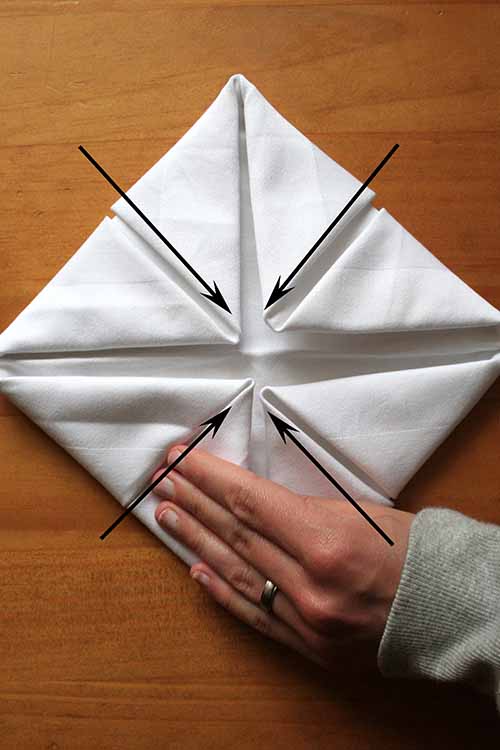
5. Gently pull out the edges underneath to form the flower's petals.
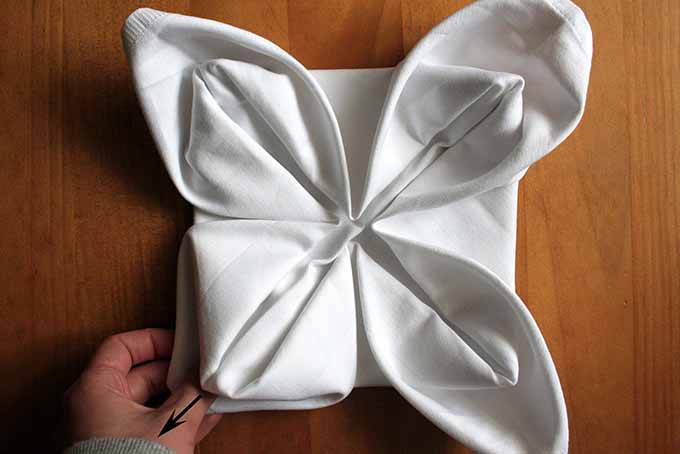
6. Pull out the edges of the four straight sides at the top, bottom, left, and right to form a diamond.

7. Arrange on the table, with some decoration or a small treat in the middle, if you like.
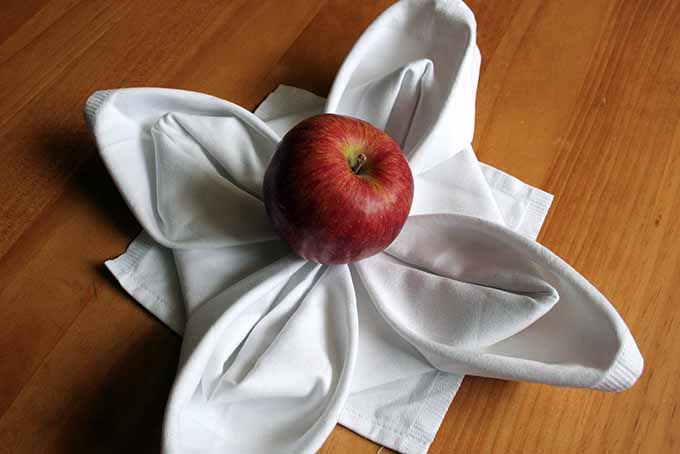
5. The French Lily
This lily pattern looks incredibly elegant on the table!
Although it is one of the most difficult techniques, you should be able to put together a wonderful shape with your first try, with practice only making it better and better.
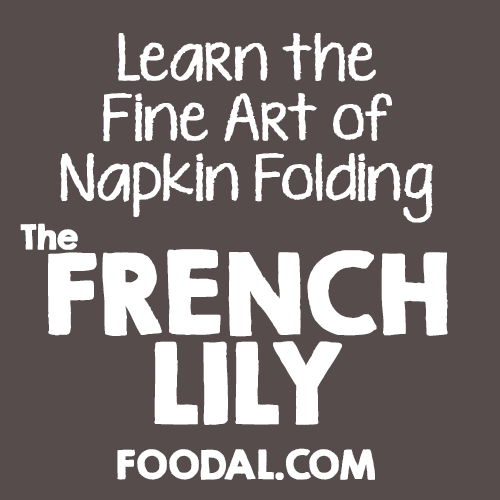
Make sure the cloth keeps its form by ironing, or pressing it together firmly after every step.
1. Spread napkin out in front of you on the tabletop.
2. Fold the lower right edge to the top left so a triangle is formed.
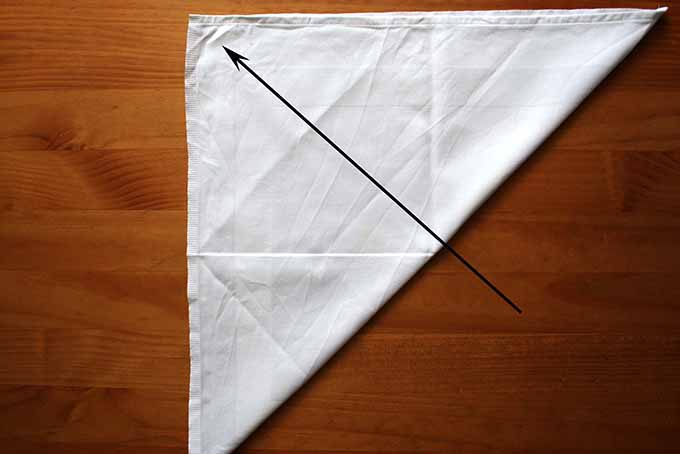
3. Place in front of you with the long side at the bottom. Fold the two lower edges in to the center diagonally.
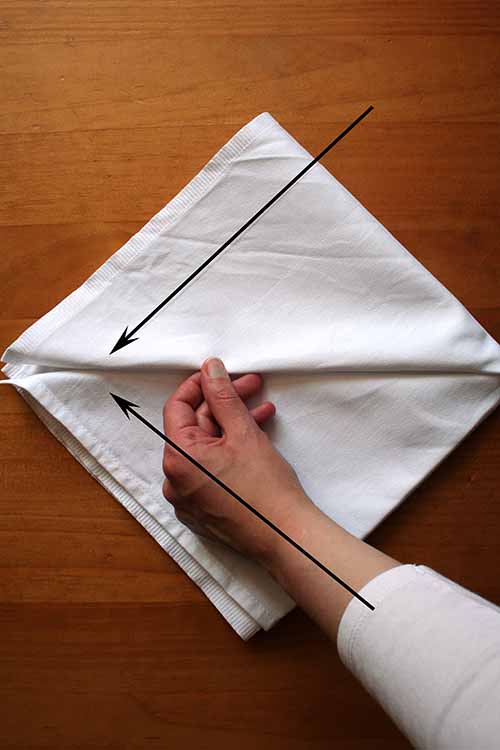
4. Bend the lower part upwards, so that an edge of about 2 inches is still visible.
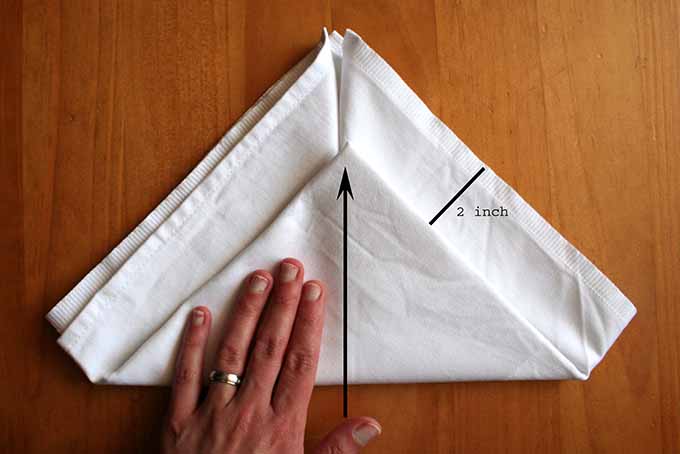
5. Bend the top of the smaller triangle so the peak is even with the bottom edge and crease.
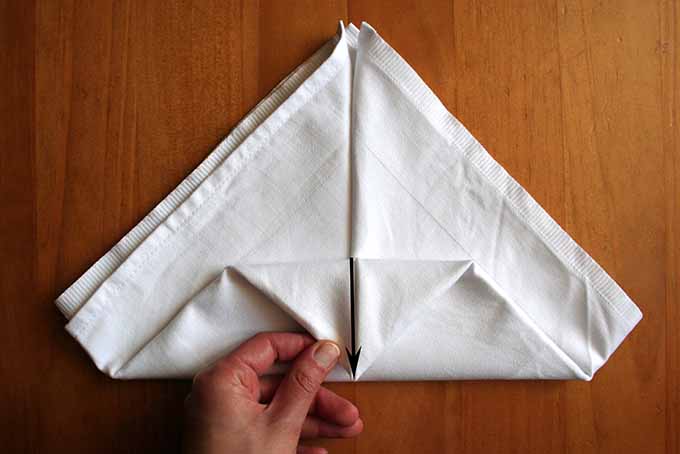
6. Carefully flip over, then bend the left and right sides into the center, and slip them into each other so they interlock.

7. Stand up the arrangement, and bend the two outer layers to the sides and down.
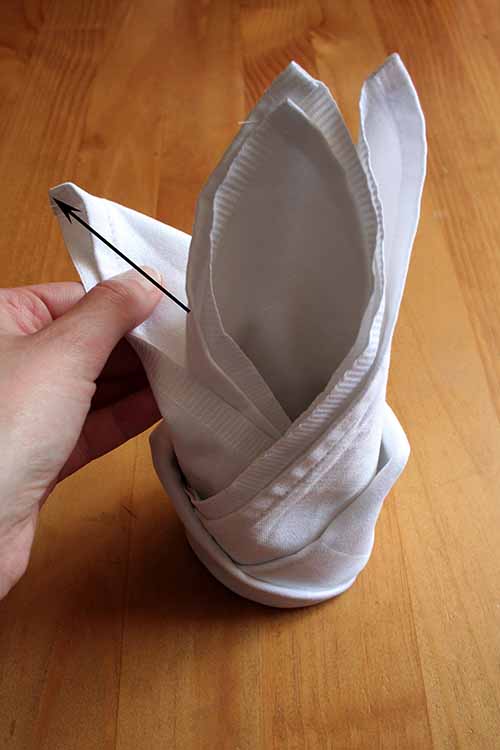
8. Arrange on the table.
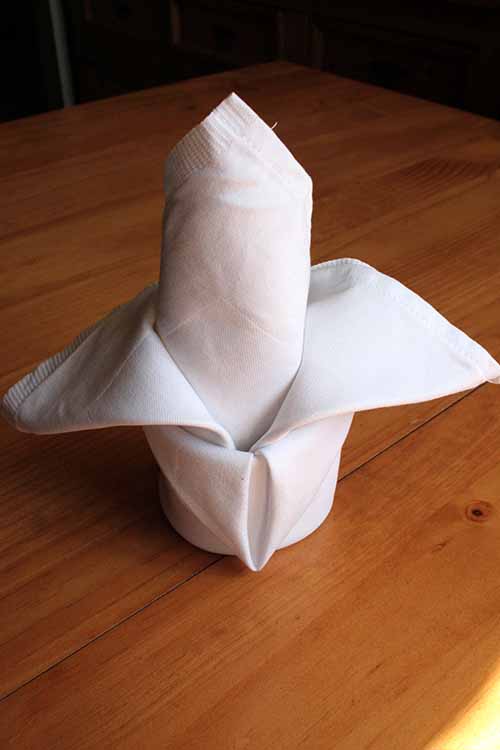
6. The Miter
What's one very classic and traditional shape? The miter.
It resembles the tall hat commonly worn by bishops, with a peaked top.
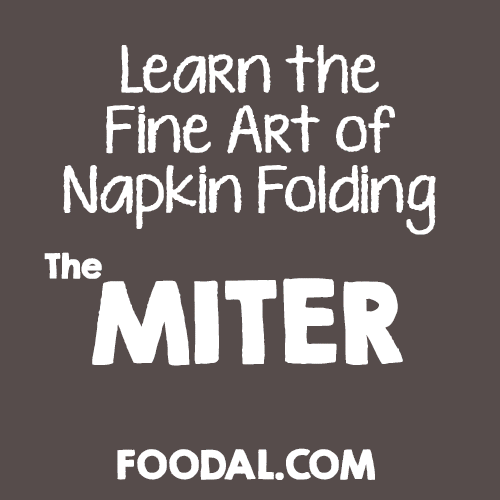
This form requires some patience when it comes to the individual steps, but it's well worth the concentration and patience required. If you follow each step closely, the miter shouldn't be a problem for you to create at all.
1. Spread the napkin out on your work surface.
2. Fold the lower half upwards, halving the napkin, and form a crease.
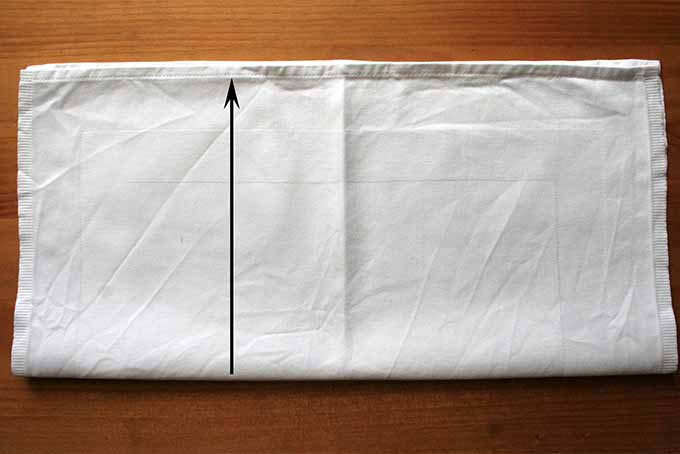
3. Bend the left lower edge up to the center, and the right upper edge down to the center.
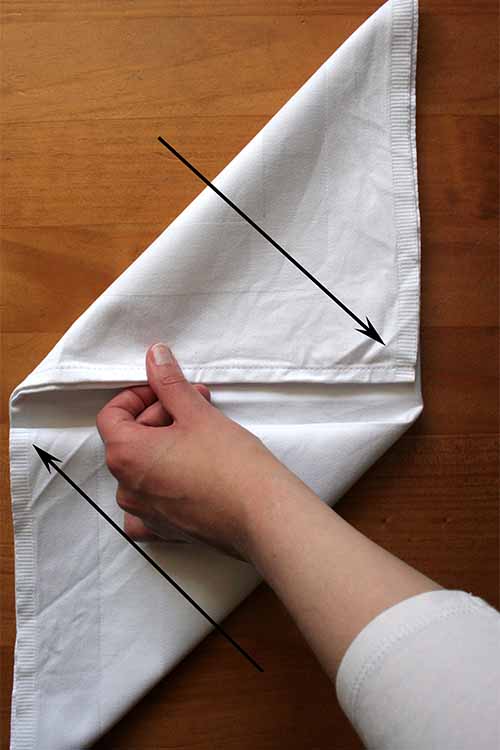
4. Flip over. Then bend the the top layer back to the left, so the tip of the triangle formed on the right is revealed.
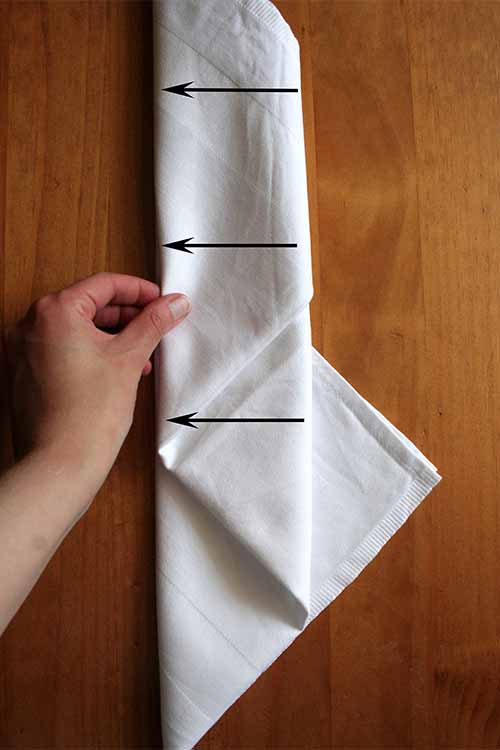
5. Unfold the tip of the top triangle from underneath.

6. Unfold this piece again, and reorient on your work surface so it's at the bottom.
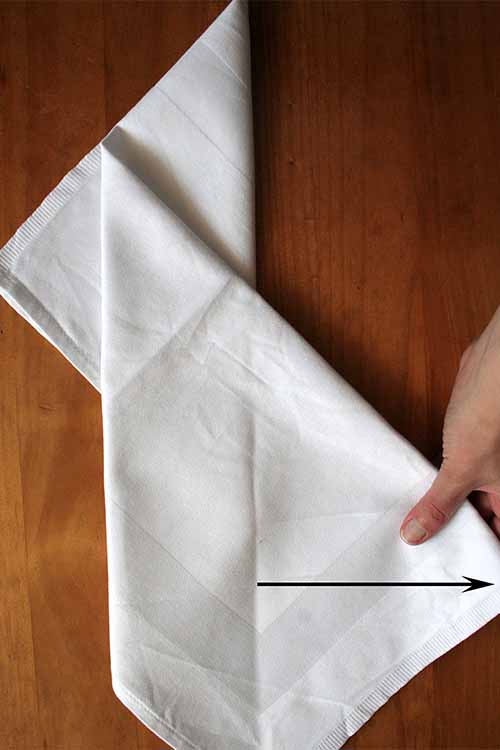
7. Fold half of the triangle at the top (upper right in the photo below) to the middle.
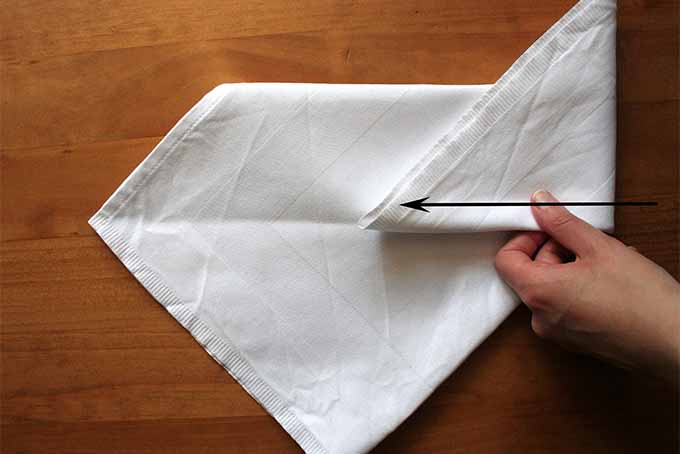
8. Fold the peak of the diamond shape back to the middle.
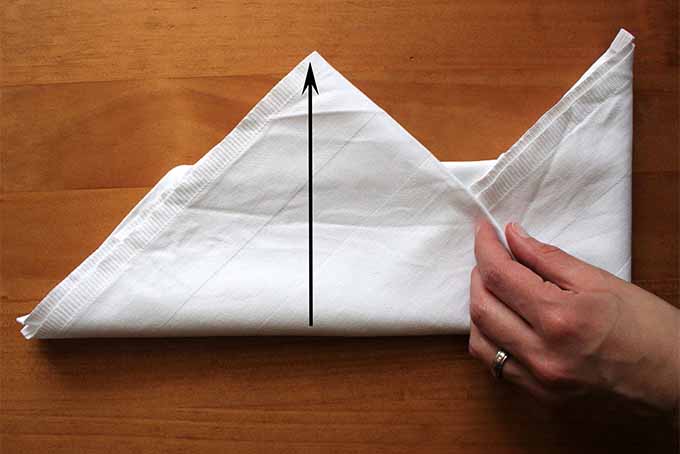
9. Flip over, then fold the right part to the center, and slip the right edge into the left one. Press or iron the creases.
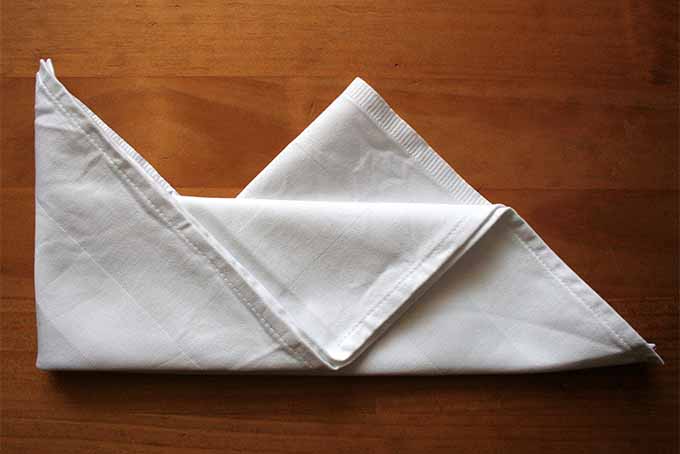
10. Prop up, opening the arrangement in the center, and stand at each place setting.

Enjoy trying these out at your own get-togethers and gatherings – and let me know how your folding skills have evolved or what new things you've learned in the process by commenting below!
Sources Cited:
1) Katharina Enzinger. "Die Bestimmung der Serviette ist die, nicht geschont zu werden." from Lothar Kolmer's "Finger fertig: Eine Kulturgeschichte der Serviette." 2008.
Photos by Nina-Kristin Isensee, © Ask the Experts, LLC. ALL RIGHTS RESERVED. See our TOS for more details.
About Nina-Kristin Isensee
Nina lives in Iserlohn, Germany and holds an MA in Art History (Medieval and Renaissance Studies). She is currently working as a freelance writer in various fields. She enjoys travel, photography, cooking, and baking. Nina tries to cook from scratch every day when she has the time and enjoys trying out new spices and ingredients, as well as surprising her family with new cake creations.
Different Types of Napkin Folding With Procedures and Pictures
Source: https://foodal.com/knowledge/how-to/napkin-folding/